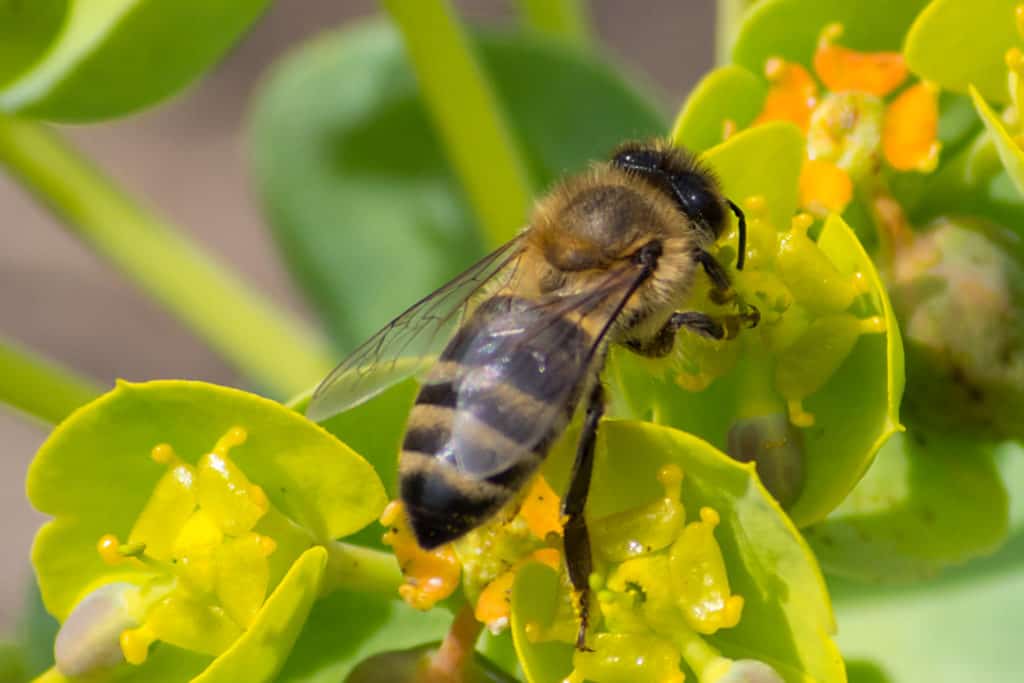
Having those solar panels can be a rather helpful addition to any home. However, there are occurrences in which they are known to lure in and kill insects. But will they also kill off bees?
Rather than killing off the bees, solar panels can actually help in the growth of a pollinator habitat, or adjacent farms and plantations that help save the bees instead.
So what’s the difference between bees and other insects, and what allows a pollinator habitat to function better around a solar plantation?
Bees versus aquatic insects
The reason solar panels have become known as insect killers, is because of the affect that they have specifically on aquatic insects. For most, if not all aquatic insects, solar panels appear to them the way that water would. It becomes a mirage the way that we believe we see water in a desert.
Aquatic insects can go over solar panels over and over again until they die, mesmerized by the dazzling three dimensional affect that it can have on their minds. They die from exhausting themselves with the constant movement towards something that doesn’t exist.

Bees aren’t considered aquatic insects, so they aren’t impacted in the same way certain species of other bugs might be.
Since a bee’s focus is most commonly honed in on the plants, flowers, farms, and gardens that they can pollinate, they have less of a tendency to be drawn in by something that resembles water, like solar panels.
(Source: Solar Panels Lure, Kill Insects : Discovery News – Seeker)
Adjacent farms and solar plantations

The EVS (Argonne’s Environmental Science) Researchers, have recently discovered that the area around a solar panel is considerably more ideal for you to plant specific plants for pollination, which is great news for the bees!
For Your Information: Pollen-bearing plants are essential for bee colonies, and their species in general. Many of these plants, such as wild-flowers, don’t require much attention or upkeep, which makes them perfect options when it comes to encouraging the presence of bees in your area.

Having these plantations will give the bees work and a reason to happily inhabit the surrounding area. Following their integration, the bees will be more capable of successfully helping the farmers in the surrounding area. The plants of those farmers give the bees work, while the pollinator plants give the bees the ability to work and have pollen for their other necessities.
So while your solar panels are most likely killing the majority of surrounding insects through a slow and deep exhaustion, they will also be able to help you create a wonderful ecosystem that you can establish overtime for the bee population to thrive.
Warning: If your goal is to carefully avoid the introduction of bees onto your land, then I wouldn’t recommend living near or creating one of these solar plantations. Solar plantations will help to increase the bee population and not kill them.
(Source: Can solar energy save the bees? (phys.org))
How the pollinator plantations are created

Unfortunately, if you are in a money saving crunch, then creating a pollinator plantation, or purchasing land around the solar panels is not a task that you should undertake. With the current undertaking of a twenty five year land lease, farmers and land owners frequently pay around $700-$1,500 per acre.
However, because of what it can do for both the bees and the farms, farmers and other land owners are starting to become increasingly interested in having solar power on, at, or near a portion of their property.
Even bee keepers have found themselves to be more interested in the project of creating a pollinator plantation in order to help increase their bee population and honey output. In which case, we can see that having adjacent solar pollinator plantations and farms, will actually increase the honey bee population.
Fun fact to consider: The interest in increasing both solar panel plantations and bee populations is beginning to go hand in hand in consideration of being able to help the surrounding ecosystem and begin to bring back more natural life.
(Source: Can Solar Sites Help Save The Bees? | Bee Culture)
Bees and Water

It may be quite clear for all of us that a honey bee is not an aquatic insect. However, in their desperation for a refreshing drink, they can sometimes take a headlong dive into the nearest source of water. Whether it’s a puddle on the driveway, or the inflatable swimming pool in your backyard, we’ve all seen the outcome of such an occurrence- the bee’s wings get wet, and it drowns.
Clearly, as it turns out, aquatic bees do not actually exist. Now usually, bees will focus on the tasks at hand, such as pollinating the surrounding plants of farmers, gardens, etc.
However, ‘bee’ aware that our little black and yellow friends do not always exceed their expected intelligence of avoiding falling into water traps. This may, on occasion lead to them being pulled in by the dazzle of water, or in this case, the dazzle of the solar panels. Because, like any other creature, bees need water to survive.
Warning: There have been times when our little black and yellow friends go towards the water and are found in pools and other such water sources. so once again, stay aware that they may not spend all of their time over a solar panel, but there is still a good chance that they will fly over it at times, possibly dying of exhaustion.
Helpful tip: Like anyone else would, even bees need a distraction in order to keep themselves from being bored. So distract them with these solar panel pollinator gardens and adjoining farm lands. You will aid in their survival and they will begin to thrive in their newly discovered homes.